Anyone who is familiar with the Japanese style of cooking has probably heard of Teppanyaki.
You can’t help but notice the sounds of food on iron plate grills when checking out the Japanese cooking.
It is one of the many popular cooking styles in Japan and it involves grilling on an iron skillet.
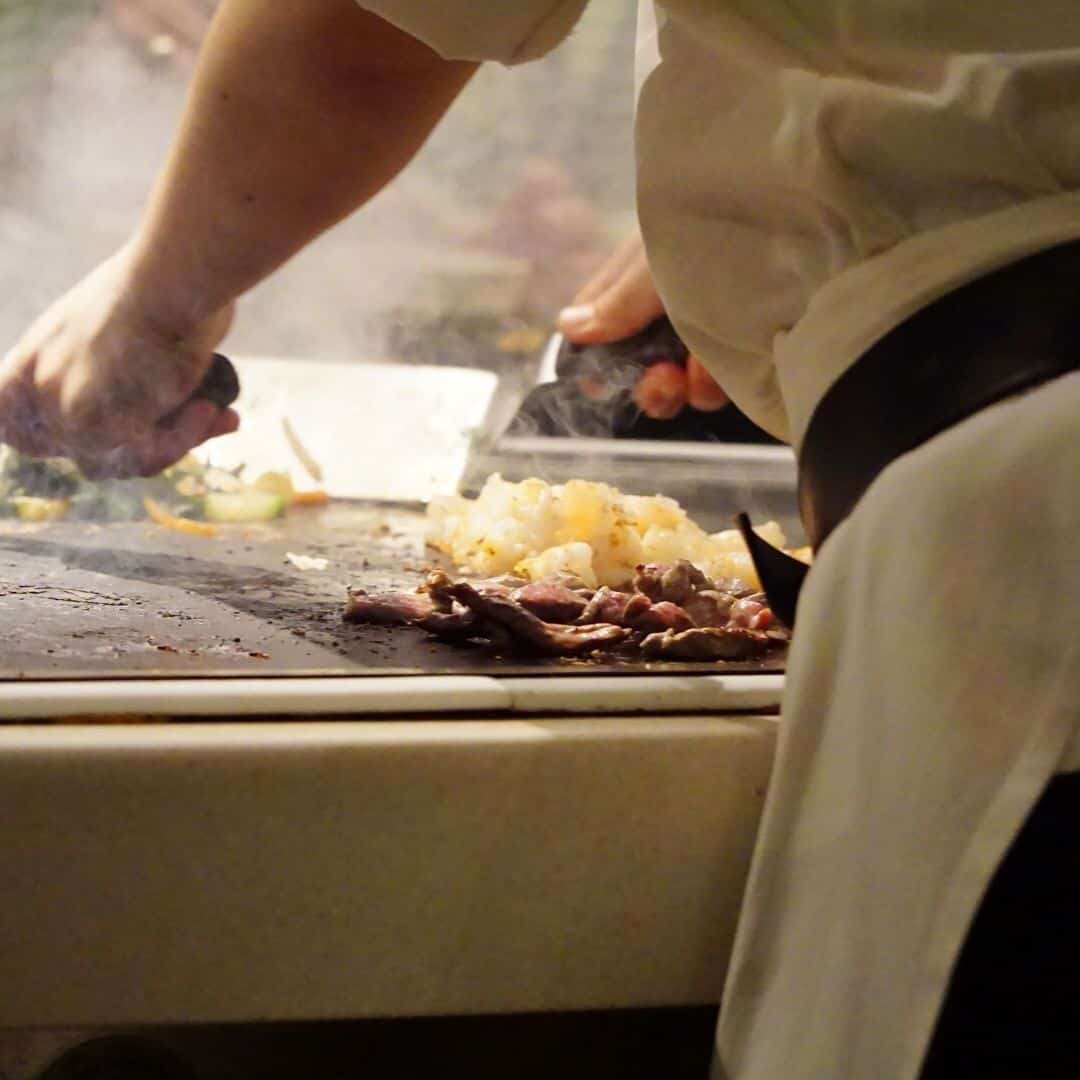
With the correct tools and equipment, it is possible to practice Teppanyaki in the comfort of your home.
Ingredients in Teppanyaki style cooking
Teppanyaki style of cooking is characterized by light seasoning and fresh, flavored ingredients.
They include:
- Meats such as steak, seafood, and chicken
- Rice, fried noodles (yakisoba), and other dough-based foods
- Okonomiyaki and monjayaki (savory pancakes with a number of different flavors and ingredients).
- Onions, mushrooms, bean sprouts , and carrots.
- Pepper, vinegar, soy sauce, wine, salt, and garlic among other seasonings.
The ingredients used in cooking Western teppanyaki are a little different from the Japanese. Beef is the most common ingredient in Western cooking.
Others include chicken, scallops, vegetables, shrimp , and lobsters, with soybean oil used for cooking them.
Here we’ve summarized it in a video for you:
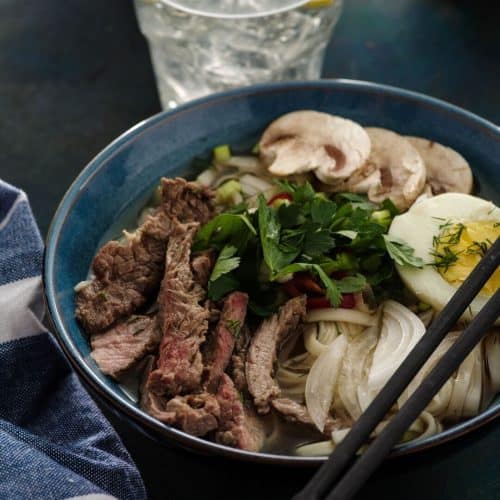 Print
Print
Teppanyaki recipe: beef Yakiniku
Delicious Teppanyaki dish using Yakiniku sauce with beef, mushrooms and zucchini. Course Main CourseCuisine JapaneseKeyword Beef, Teppanyaki Prep Time 15 minutesCook Time 20 minutesTotal Time 35 minutes Servings 4 people Author Joost Nusselder Cost $20Equipment
- Teppan
- or: large skillet
Ingredients
- 1 lb beef for Yakiniku sliced
- 2 large white onions sliced
- 1 zucchini sliced
- 1 bell pepper sliced
- 16 mushrooms
- 1/4 kabocha pumpkin (Japanese pumpkin) or a winter squash will do as well
- 2 tbsp vegetable oil
Yakiniku sauce
- 1/4 cup soy sauce
- 2 chili peppers dried
- 2 tbsp sugar
- 2 tbsp mirin
- 1 tbsp garlic grated
- 1 tbsp ginger grated
- 1/2 tbsp grounded sesame seeds
- 1 tsp sesame oil
- 1 handful cilantro chopped
- 2 eggs boiled
Instructions
- Start by making the Yakiniku sauce. Add sliced chili pepper and all the other ingredients, except sesame oil, into a pot then cook and stir until it starts to boil. Add the sesame oil and stir for another 2 minutes.
- Slice onions into 1/2’’ thick and pepper into ½’’ width. Slice Kabocha pumpkin and zucchini into ½’’ thick. Cut off the stems from mushrooms and slice them in three thin slices each.
- Boil the eggs for about 5 minutes and cool them off under cold water. Peel them and set aside.
- Heat the vegetable oil on the teppan (or skillet) at high heat. Start by grilling the vegetables because they will take longer than the meat, then cook the sliced meat alongside the vegetables on the teppan (or use a separate skillet for the meat) and add the Yakiniku sauce to the meat.
- The vegetables should be done after about 12 minutes and the meat in about 8. Use the grill scrapers to move around the vegetables and meat a few times during this time to make sure every side gets evenly grilled.
- Serve the meat and vegetables in a bowl with some noodles or steamed rice underneath and add the cooked egg, you can halve them per bowl, and add freshly chopped cilantro.
How teppanyaki cooking is performed
The ingredients used in preparing the Japanese teppanyaki are yakisoba, sliced meat or seafood, and cabbage. Vegetable oil, animal fat, or a mixture of both is used in the cooking.
Kobe beef is the most common in restaurants but is a bit expensive though it’s of much higher quality. Less expensive meat from the USA and New Zealand are also available.
The beef cuts are either choice sirloin or tenderloin.
The dishes come with a variety of side dishes such as zucchini, mung bean sprouts, crispy garlic chips, and fried rice. In Japan, only soy sauce is available but other Western restaurants provide dipping sauces as well.
Teppanyaki food may be outstanding in taste, but wait until you see how it is prepared. A teppan grill is placed on the table where you will be seated before the chef begins the outstanding performance.
As the years go by, teppanyaki has evolved. It is not about cooking anymore, but it became a form of art.
The Japanese are known for their creativity and they have a reputation of turning basically anything into a form of art, and cooking is no exception.
Teppanyaki cooking began in Tokyo as locals began using a hot plate grill and one can’t help but notice that not every aspect of this cooking style is Japanese.
It came as a surprise to the locals when a restaurant in downtown Tokyo known as Misono began using a table-side grill to do its cooking in 1945.
A combination of entertainment and Teppanyaki dishes such as ‘flaming onion volcanoes’ propelled Misono to global fame.
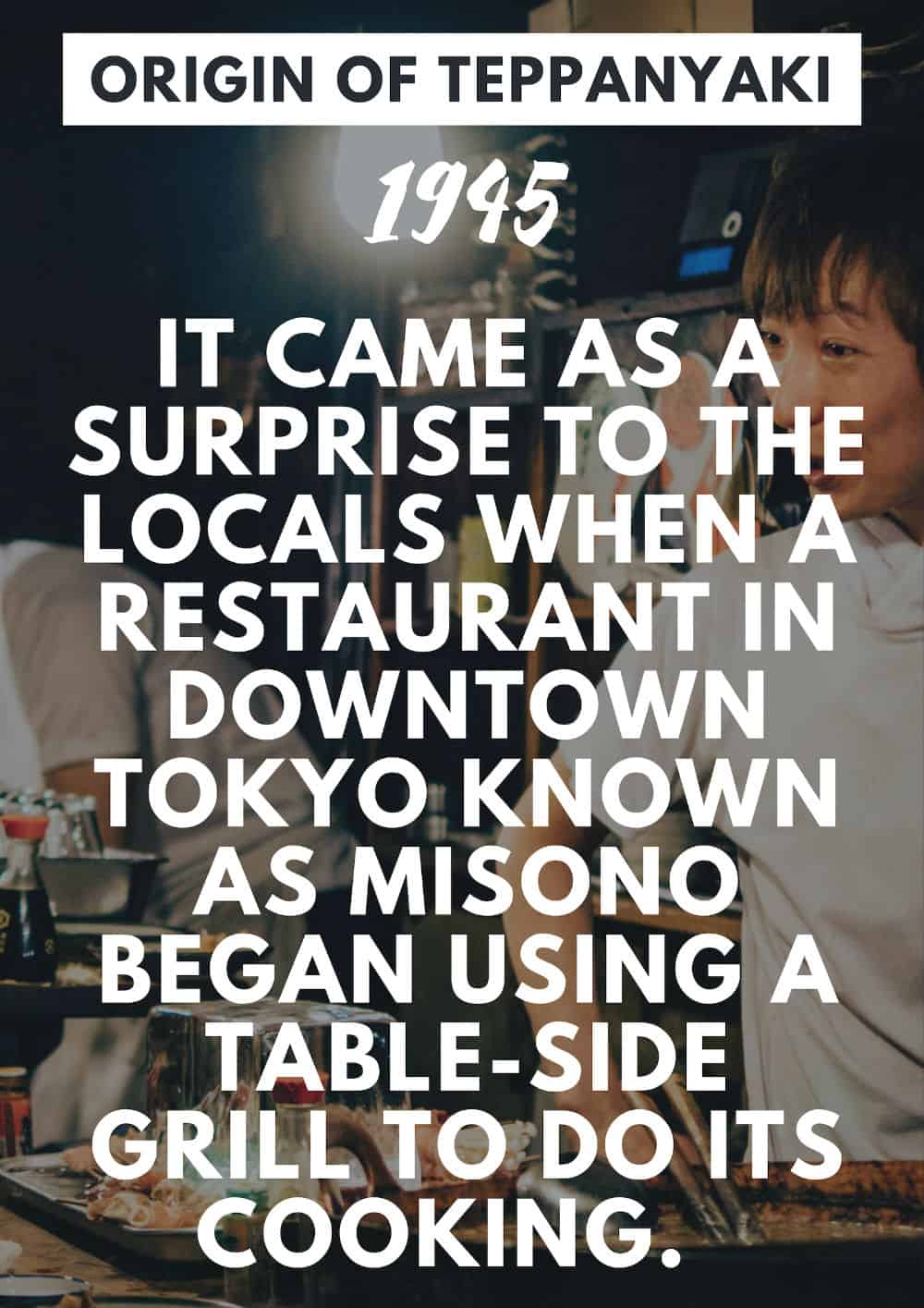
Plus points of Teppanyaki dishes
Teppanyaki dishes are very low on fat and are considerably light since very little oil is involved in the cooking.
When ordering teppanyaki dishes in a restaurant, you are given the option of deciding exactly how you want it prepared.

You can decide the kind of seasoning and the amount of oil that suits your taste. The food comes in small portions but adequate. It is the kind of food that would definitely be recommended for health-conscious folks.
It is also safe to say that the ingredients used in teppanyaki cooking are recommendable as far as health is concerned.
The popularity of Japanese steak houses has made Teppanyaki a household name in America. The teppanyaki style of cooking is also used in preparing yakisoba (noodles) with seafood or sliced meat using vegetable oil or animal fat.
It has evolved over the years into an interesting style that is no longer considered as just cooking but as a form of art.
The knife, fork, and spatula are flipped, tossed, clanged, and drummed together creating a rhythm that will definitely capture your attention.
The feast will then begin with the chef’s skillful chopping and dicing of the food which is then placed on a grill that is already aflame.
The result is not only appealing to the eye but the taste will leave you longing for more.
If you are lucky to get a truly creative chef, you may witness some of the following tricks:
- Catching an egg with the hat
- Flipping of a shrimp tail into the shirt pocket
- Splitting an egg mid-air with a spatula
- Flipping pieces of shrimp into your mouth
These are just but a few of the many tricks you may come across. You will also have the privilege of choosing your own chef and how you want the food prepared.
Teppanyaki cookbooks to get you started
If you want to get started in Teppanyaki cooking at home, you can get a lot out of the right information and there are not that many good cookbooks out there.
If you like a little more backstory and history about the author and how he came to be a great teppanyaki chef, then Teppanyaki: Modern and Traditional Japanese Cuisine by Hideo Dekura is a great read.
It has 60 recipes ranging from beef to lamb and seafood and with a lot of explanation about each of these types of teppanyaki.
If you like a more detailed guide on the best recipes, and a little less of a story, then the Barbecue in Style A Teppanyaki Adventure is the one you should opt for.
Teppanyaki Chef Supplies, these are 5 things you don’t want to forget
Every professional Teppanyaki chef has four words that describe him or her—mastery, expertise, precision, and showmanship. In addition to having the skills of an experienced chef, Teppanyaki chefs must also add the art of performance while cooking.
Many Teppanyaki chefs usually entertain diners not only with the taste of their meals but also with an interesting collection of amazing skills and tricks that they use to prepare these meals.
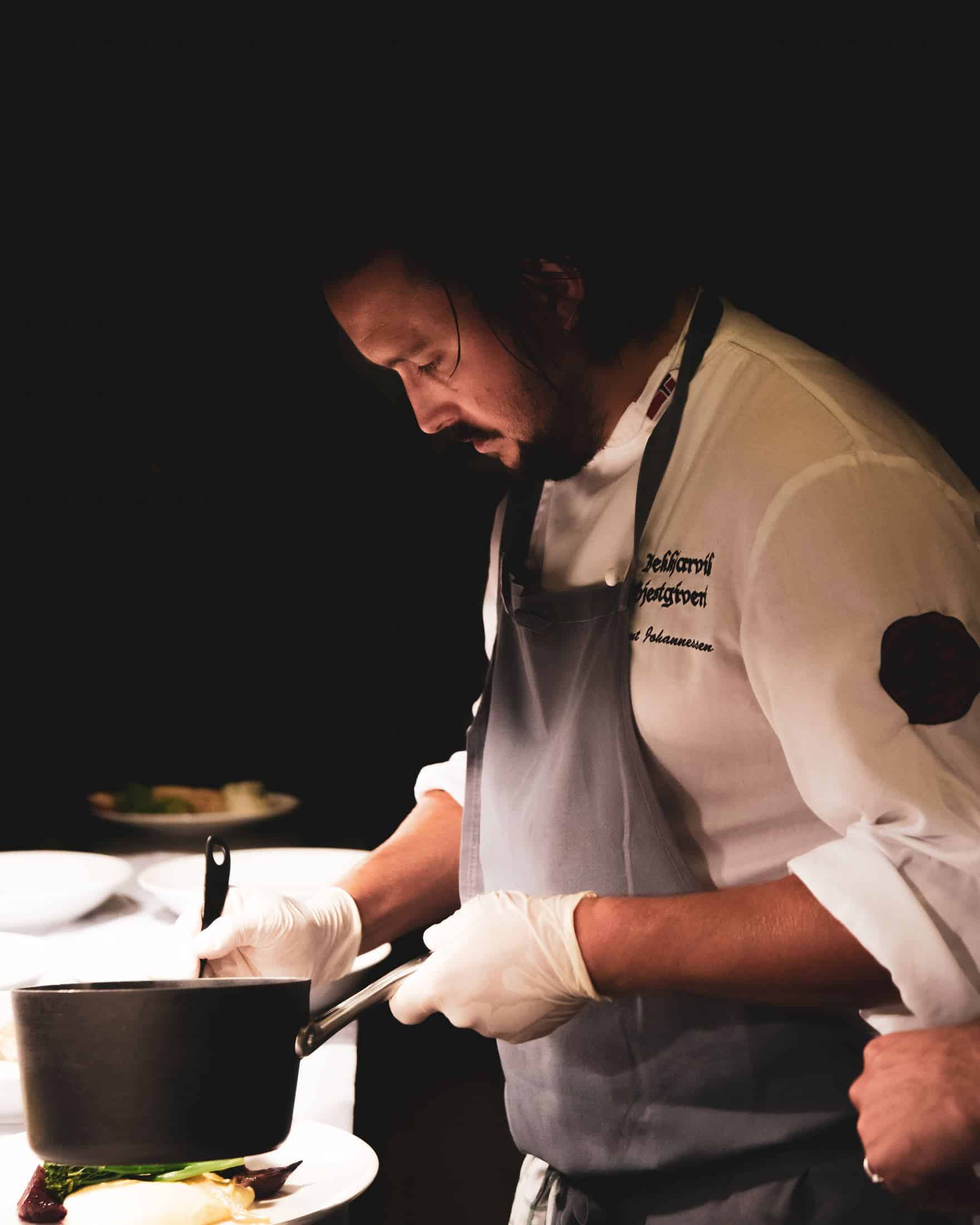
It requires endless commitment, practice, and time to master the art of Teppanyaki chefs.
In addition to this, you will also need some important tools and supplies to make your Teppanyaki chef dream come true.
Other than a professional Teppanyaki griddle, you will also need the following supplies:
Professional Stainless Steel Griddle Cooking Kit
The Professional Stainless Steel Griddle Cooking Kit will give you everything you need when it comes to Teppanyaki Grilling.
This griddle set comes with 10 pieces of quality products, which will make your Teppanyaki cooking easier.
The set has two spatulas, two bottles, two flippers, one scraper, two egg rings, and a carrying case. This carrying case is designed to make carrying the tools easier while on the move.
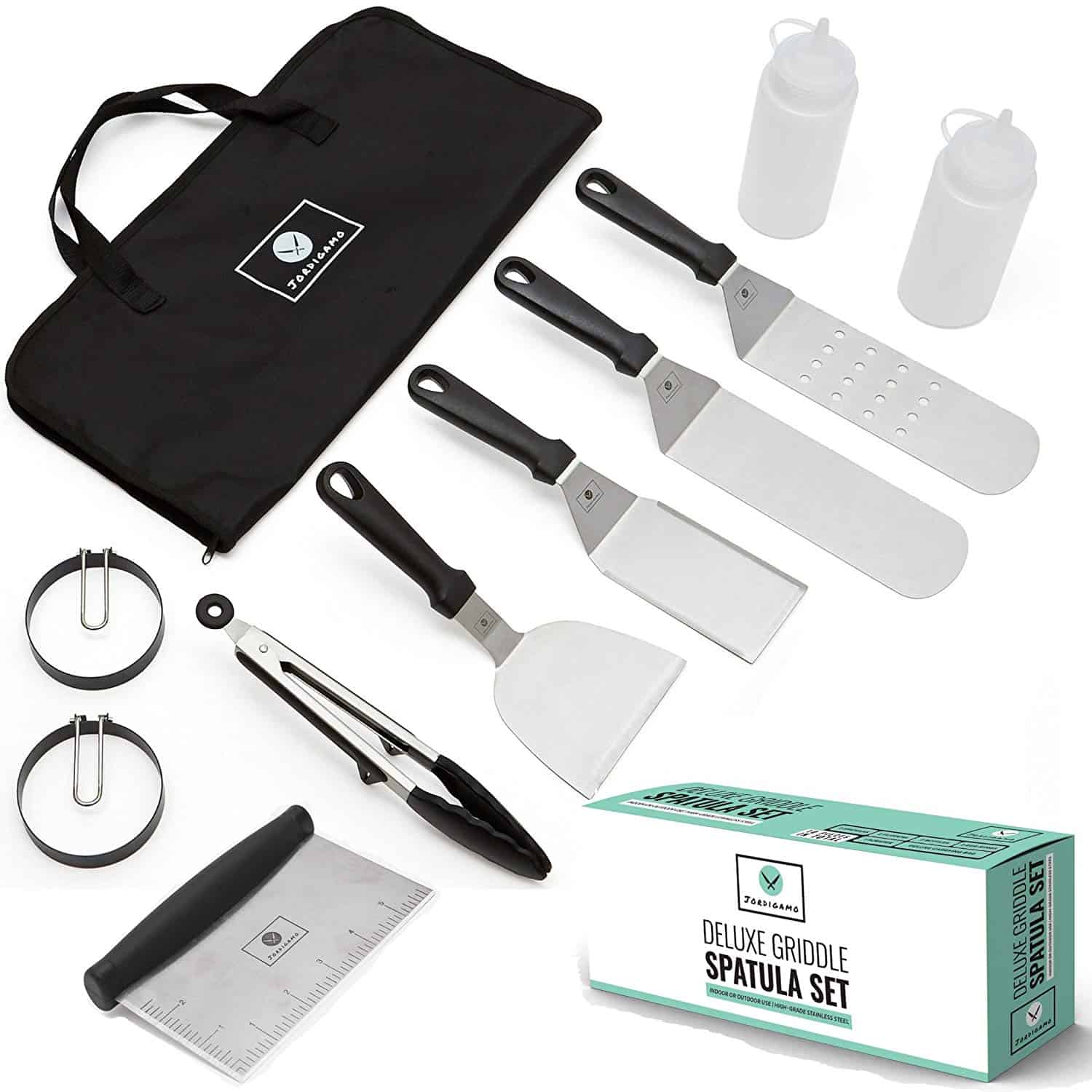 (view more images)
(view more images)
Getting this Professional Stainless Steel Griddle Cooking Kit will be a great addition to your grilling accessories. The quality of the metal used to make these tools can withstand any heat during grilling.
Notable features:
- Strong and durable stainless steel (chef-approved) – this is one of the best Teppanyaki Grill set that you will find in the market. This kit is approved by professional chefs and has been made with high-quality metal, which is ideal for all your grilling needs. The griddle set is suitable for camping, outdoor use, Teppanyaki use, hibachi grilling, as well as restaurant use. Since this griddle set is made out of professional grade metal, all the accessories will work perfectly on your grill.
- Durability – most people have complained about getting grilling tool sets that don’t last long. However, that’s not the case with the Professional Stainless Steel Griddle Cooking Kit. This griddle set has been designed with top quality materials, which is meant to last for long. The manufacturer wants the customers to be satisfied as they cook. Most professional chefs love this griddle set because of its quality material, as well as durability.
- This will make a great gift for your friends – the Professional Stainless Steel Griddle Cooking Kit is an amazing gift that can assist you in Teppanyaki grilling, whether indoors or outdoors. You can go tailgating or camping with this set and you won’t need any other tool. The high-quality material used to design this set is meant to last, and tools will make every grilling experience memorable. Therefore, you can gift this Professional Stainless Steel Griddle Cooking Kit to your friends if they love Teppanyaki grilling.
Are you doing a lot of fish on your Teppanyaki plate? Check out these top fish pliers for removing your fishbones
HHXRISE Large Organic Bamboo Cutting Board for Kitchen
As a Teppanyaki chef, you will need a cutting board to help in the preparation of your materials.
The HHXRISE Large Organic Bamboo Cutting Board For Kitchen is a quality tool that will assist you in your cooking process. This large cutting board is made out of quality wood, which ensures its durability.
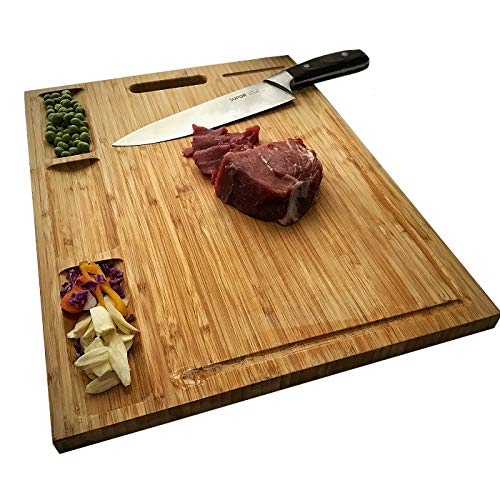 (view more images)
(view more images)
Notable features:
- The board is made out of organic bamboo, which is BPA free – if you are looking for a cutting board which is made out of strong wood, then you have found it. The HHXRISE Large Organic Bamboo Cutting Board For Kitchen is made out of 100% natural bamboo, and it is antibacterial, antimicrobial, and BPA free. The board has been polished to achieve smooth surfaces.
- Extra thick and large to accommodate all your cooking materials – this cutting board has a measurement of 0.72 x 12 x 17 inches, and it is sturdy, thick, and big. You can use this cutting board as chopping, cutting, carving board, serving tray, or even cheese board.
- A unique design with juice grooves and built-in compartments – this cutting board has a very distinct design, with 3 built-in and separated sections on its sides, where you can temporarily put your ingredients before you start cooking. In addition to this, the board has a juice groove, which prevents the juice from spilling over to the counter. With this HHXRISE Large Organic Bamboo Cutting Board For Kitchen, you won’t mess your kitchen again with spilled juices.
- Versatility – this isn’t just a mere cutting board. Its unique design also converts it to be a tray holder, which you can use to serve your grilled food.
- Knife friendly – the material used to make this grill will not dull your knife. However, you should never use a dishwasher to clean the cutting board.
Ginsu Gourmet Chikara Series Forged 19-Piece Japanese Steel Knife Set
The designers of this magnificent knife set have been in business for over 40 years.
They created the famous quote, “but wait, there’s more,” and also invented the first knife that never required any sharpening. Ginsu is a company that has always pushed the innovation of knives to the limit.
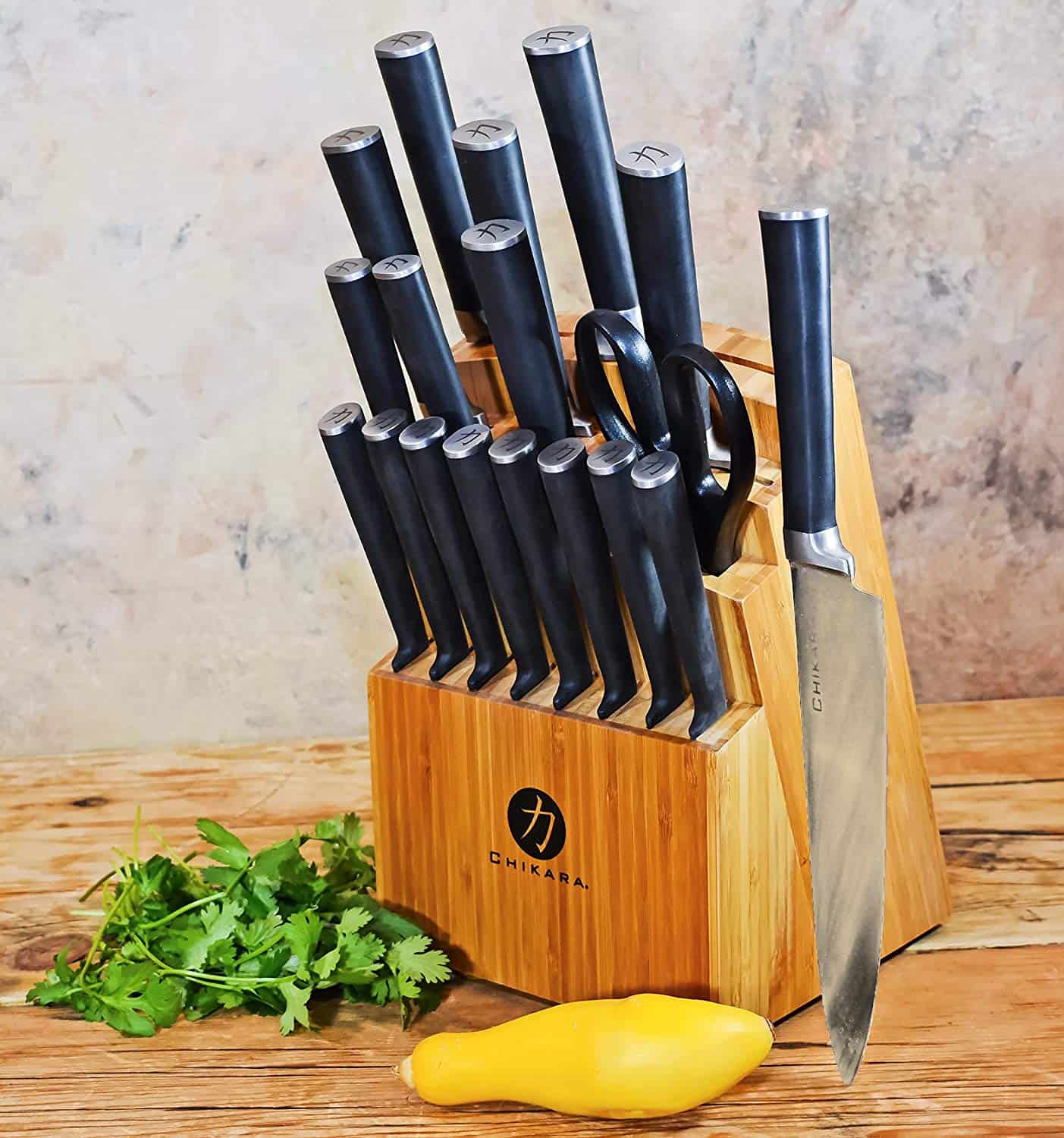 (view more images)
(view more images)
What you might not realize is that this knife is that its design, engineering, and assembling is done in the US. The factory has a dedicated team of engineers, who work around the clock to deliver quality products.
When you look at the Ginsu Gourmet Chikara Series Forged 19-Piece Japanese Steel Knife Set, you will see the style, color, as well as count that will perfectly blend in your kitchen.
Therefore, whatever you need, Ginsu has the right answer for you.
This knife set included everything that you need to prepare and serve your complex and delicious meal. The knives are organized in a stylish Bamboo Fish Block. They include:
8-Inch Chef’s Knife
• 8-Inch Bread Knife
• 8-Inch Slicer
• 7-Inch Santoku Knife
• 6-Inch Boning Knife
• 6-Inch Cleaver
• 5-Inch Utility Knife
• 3.5-Inch Paring Knife
• Kitchen Shears
• Honing Rod
• Eight 4.5-Inch Steak Knives—note that the steak knives are not forged, but they are stamped
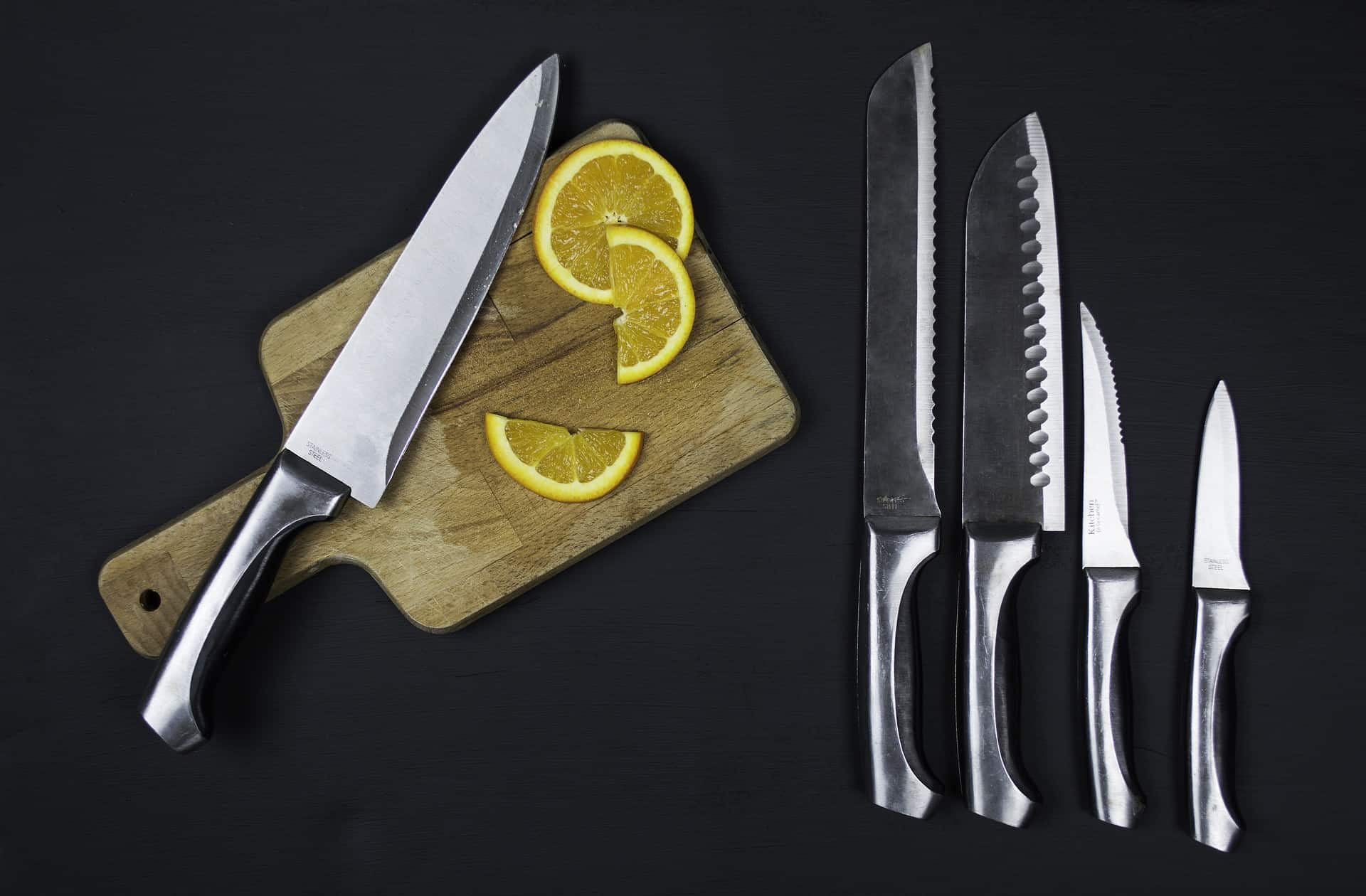 (view more images)
(view more images)
That’s why many Teppanyaki chefs love this knife set since it has all the knives required in Teppanyaki Cooking.
So, why do many chefs love this knife set?
- It’s maintenance free – this knife set will arrive razor sharp, and you will not have to sharpen it—thanks to its unique scalloped sharpness. These are high-quality knives that you can depend on whenever you are preparing any meal.
- Remarkable performance – unlike other serrated knives, the Ginsu Chikara knives are usually sharp on both sides, which allows you to enjoy the performance of a fine edged knife.
- Strong and durable construction – one notable thing about the knives in this set is their full tang blade, which has a triple-rivet blade with ergonomic design. The handle will give you a secure and comfortable cutting experience.
- Designed to last – the Ginsu Chikara knives are designed from a single piece of top-quality Japanese stainless steel from their tip to tang. This means you can approach any recipe with the confidence that this knife will not fail you.
- Versatility – one notable thing about the Ginsu Chikara knives is that they are well balanced, and this allows you to enjoy the perfect blend of control and power that you need to use even in the trickiest part of the recipe.
- Manufacturer’s warranty – another interesting thing about the Ginsu Chikara knives is that they come with a Lifetime Limited Warranty. The Consumer Report has named these knives “Best Buy” for 5 times.
TOPTIE Unisex Short Sleeve Chef Coat Jacket
The TOPTIE Unisex Short Sleeve Chef Coat Jacket has been designed to suit all your needs as a Teppanyaki chef.
Getting one of these jackets will give you a professional chef look, at a very great value, and you will discover that they are perfectly suited for your work.
The jackets come in different colors, which means you can choose the color that suits you the best.
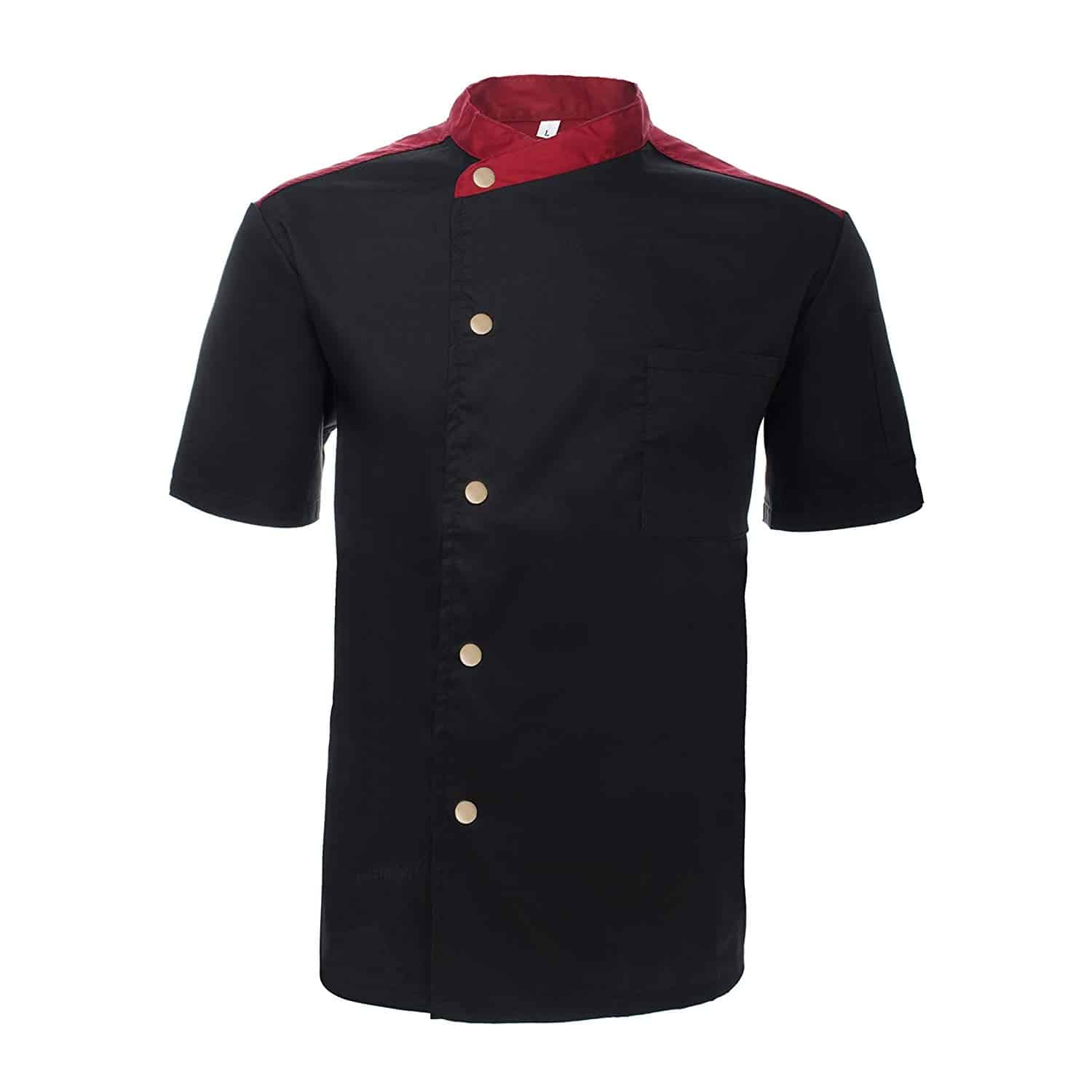 (view more images)
(view more images)
One notable thing about the TOPTIE Unisex Short Sleeve Chef Coat Jackets is that they are designed with 35/65 cotton/poly fabric.
In addition to this, they have a double- breast, short-sleeve design, with matching buttons.
Notable features:
- The fabric is breathable and will allow you to enjoy good mobility
- A super soft and standup mandarin collar style
- Thermometer pocket that allows you to keep things like thermometers and pens close
- The sizes do differ
Also read: see what they do with chefs tools at Benihana
Sharp Pebble Premium Whetstone Knife Sharpening Kit
A sharpening stone is an essential tool for any Teppanyaki chef since you cannot afford to work with a dull knife.
The Sharp Pebble Premium Whetstone Knife Sharpening Kit comes with a double-sided premium quality whetstone (#1000/#6000), a bamboo base for holding your stone, a knife-sharpening angle-guide, as well as an instruction manual.
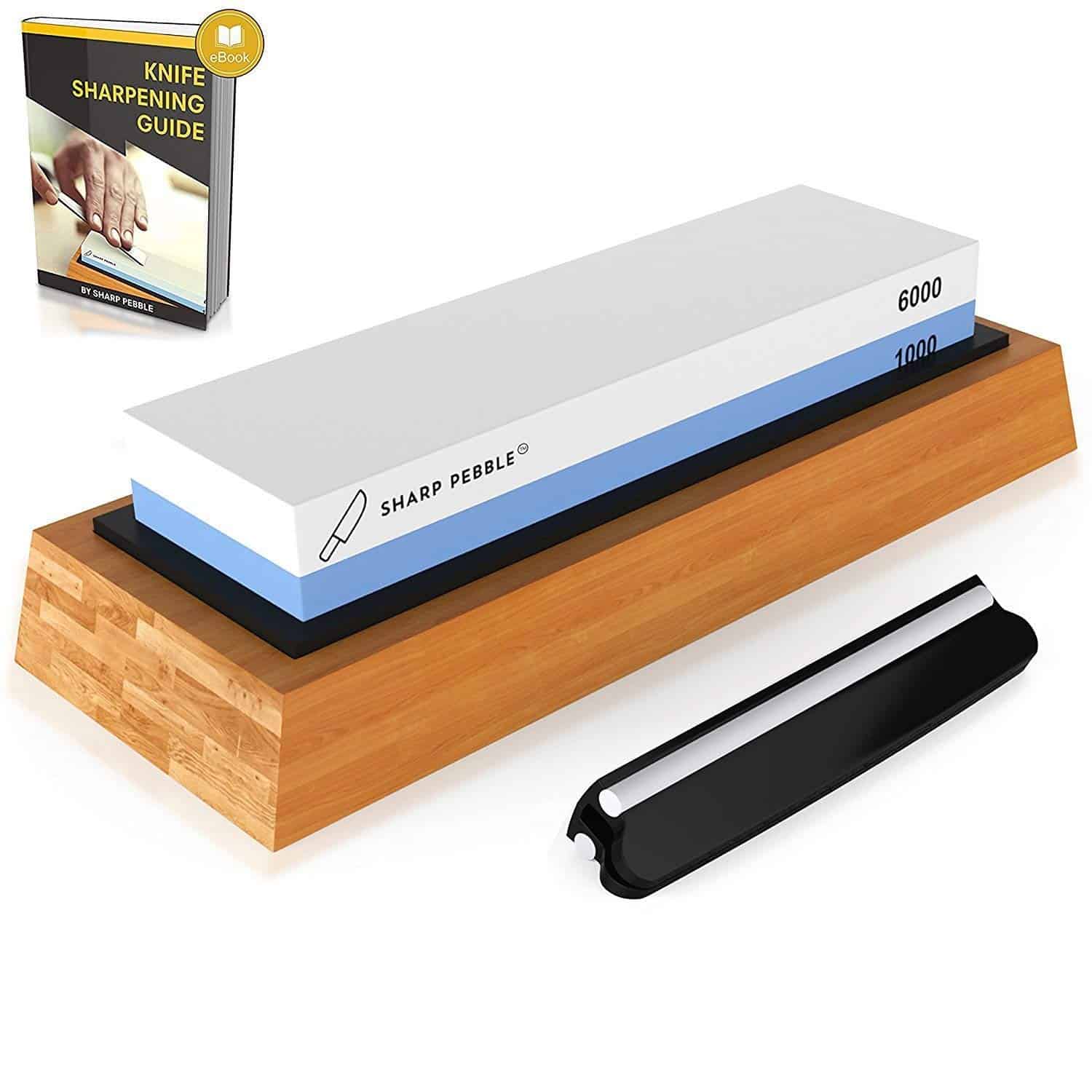 (view more images)
(view more images)
Notable features:
- Versatility – this is a durable and long-lasting sharpening stone. In addition, it can sharpen any blade, regardless of the brand.
- Easy to use – the sharpening stone is easy to assemble and use. In addition to this, the stone requires water, and you won’t need to use expensive honing or sharpening oils.
- Safety – safety is paramount when it comes to handling a sharpening tool. That’s the reason why this stone comes with a silicone base, which holds the stone inside the non-slip bamboo base. The setup ensures that your stone remains in one place as you sharpen it.
- Premium quality – this is a simple, but an unmatched tool that you can use even at home. Also, you can use it to gift your friends.
These are the most basic supplies every Teppanyaki chef needs, although you might see some Teppanyaki chefs with other tools other than the ones we have mentioned above.
These tools will make your work as a Teppanyaki chef easier, and you will not need any other tool, other than these.
Planning to cut raw fish or octopus? Check out these Takohiki chefs knives to get the job done professionally.
What Teppanyaki is all about
Teppan is Japanese for iron pan while yaki means grilled. Teppanyaki is mainly characterized by fresh ingredients and light seasoning.
This style of cooking enhances the original flavor of the ingredients rather than cover-up them up.
The common seasonings involved in teppanyaki cooking are wine, soy sauce, salt, pepper, and vinegar. Garlic is also used in plenty especially when preparing meat, chicken , and bean sprouts.
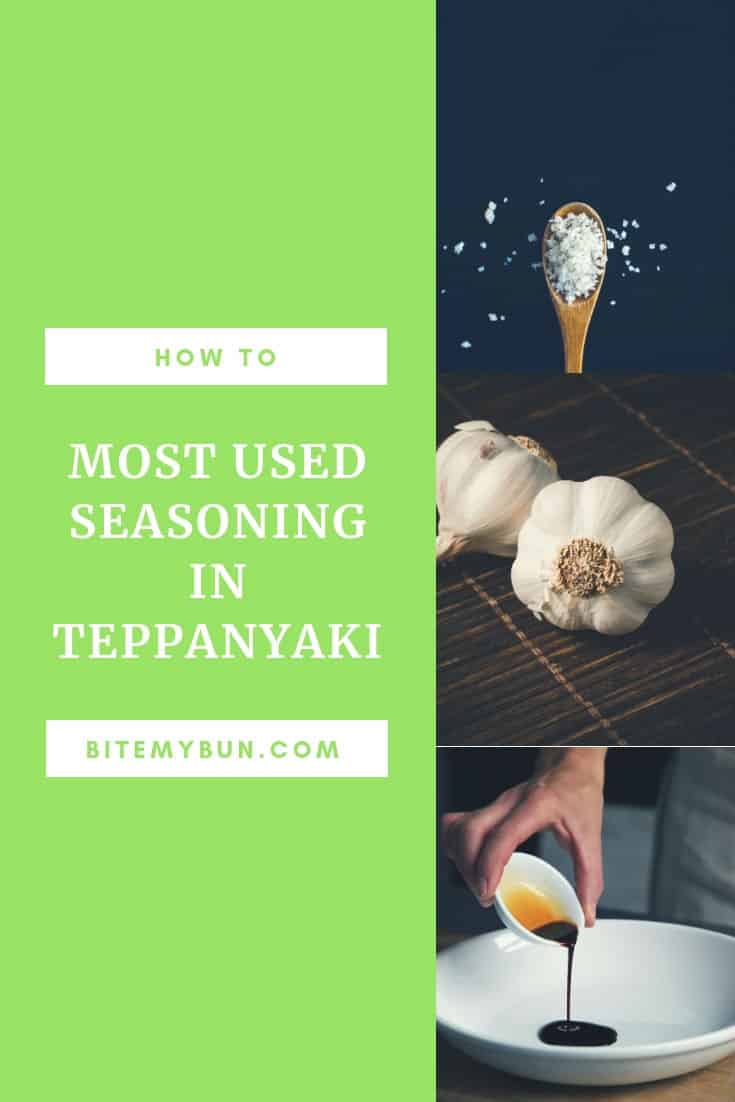
All kinds of beef from different geographical regions feature in teppanyaki dishes. You will have to dig deeper into your pocket for Japanese beef from regions like Kobe, Akita, and Matsusaka.
The highest quality of Japanese beef is believed to be produced from cows that receive special treatment such as music and massage.
These 3 things make typical Japanese Teppanyaki Food
Teppanyaki is a Japanese-style cuisine that utilizes an iron cooking device with a flat surface to cook food.
Teppanyaki comes from the Japanese term teppan, meaning iron plate, and yaki, meaning pan-fried, grilled, or broiled.
Therefore, the term teppanyaki literally translates to pan-frying, grilling, or broiling on an iron plate.
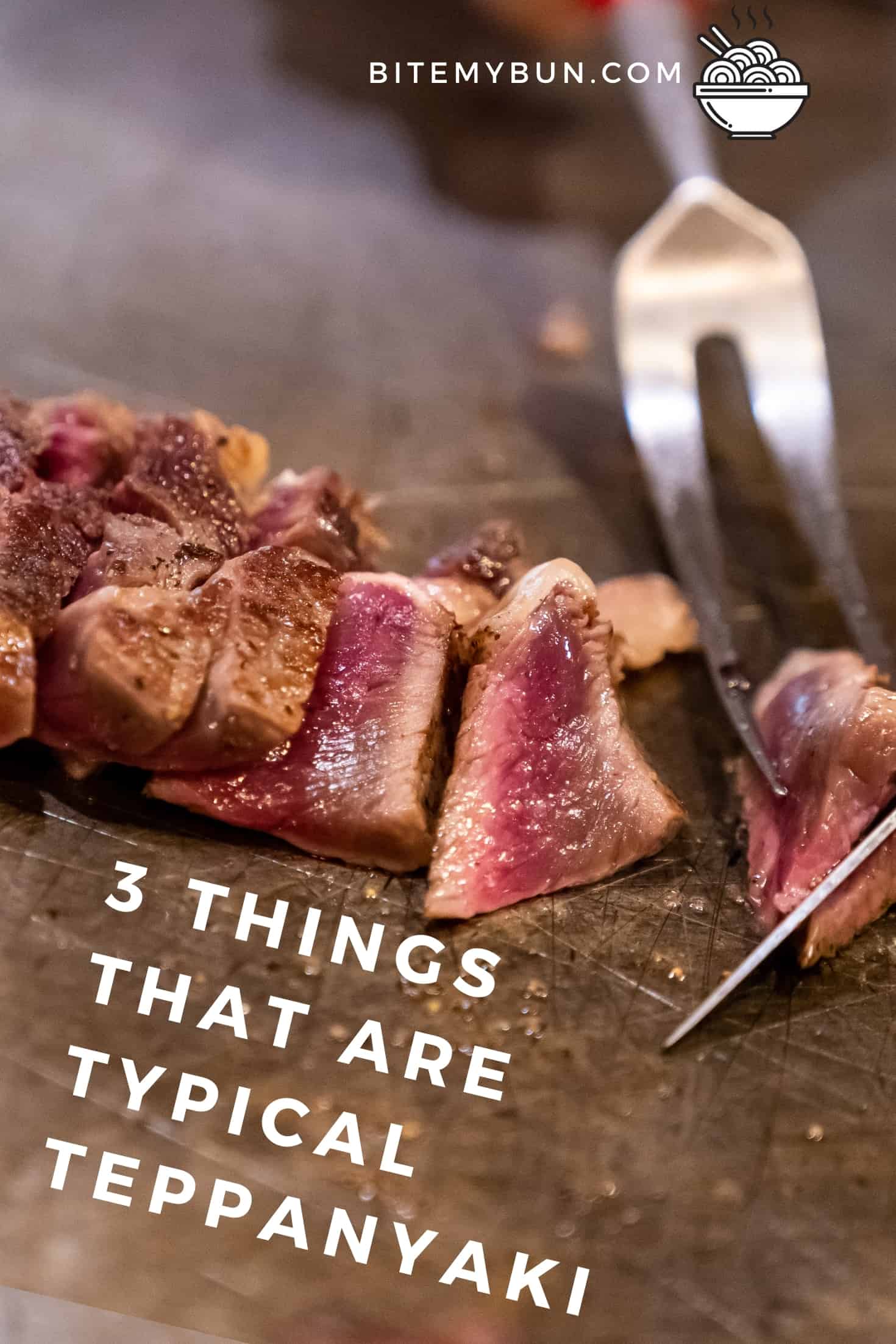
In addition, teppanyaki is inspired by Western side dishes and Eastern flavors.
One of the perks of ordering a teppanyaki cuisine is its versatility. You can definitely choose your desired ingredients and even the amount and type of oil and seasoning.
Typical Teppanyaki food consists of well-seasoned meat, fish, or vegetables in most often at least soy sauce, vinegar, garlic, and pepper and is grilled in vegetable oil. It is served as a main course with multiple side-dishes to accompany the main dish:
- it’s grilled on a flat surface
- it’s served as several side-dishes with the main course
- it uses fish, vegetables, or meat with vegetable oil and spices
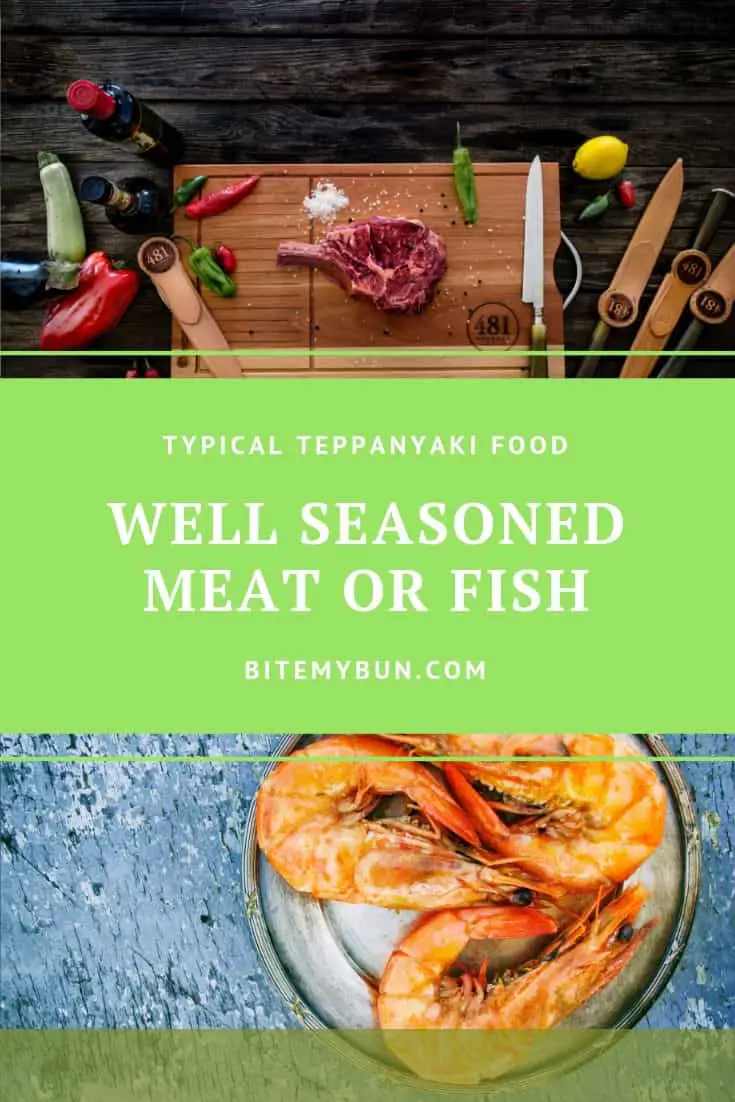
I have a lot of fun making it at home and you can too with these great teppanyaki knives.
Equipment and Ingredients Used in Teppanyaki Cuisines
Wide and flat iron grill, known as a teppan grill, is the primary equipment used in preparing teppanyaki cuisines.
Usually, the teppan grill is situated tableside with the chef preparing food in front of the customers.
In addition to the teppan grill, other equipment includes metal spatulas, grill fork, and huge, razor-sharp knife. These are all needed to manipulate the ingredients.
Also read our article on the essential teppanyaki tools
What can you typically find in a Teppanyaki restaurant?
Many teppanyaki restaurants utilize costly, high-quality ingredients, thereby making this cuisine a fancy meal for special events or occasions.
Teppanyaki can be primarily made:
- with seafood
- steak
- chicken
- dough-based ingredients such as fried noodles or yakisoba and rice also comprise this cuisine
Other ingredients include seasonings (wine, soy sauce, vinegar, pepper, salt, and garlic) and minced or cut veggies (bean sprouts, carrots, mushrooms, and onions).
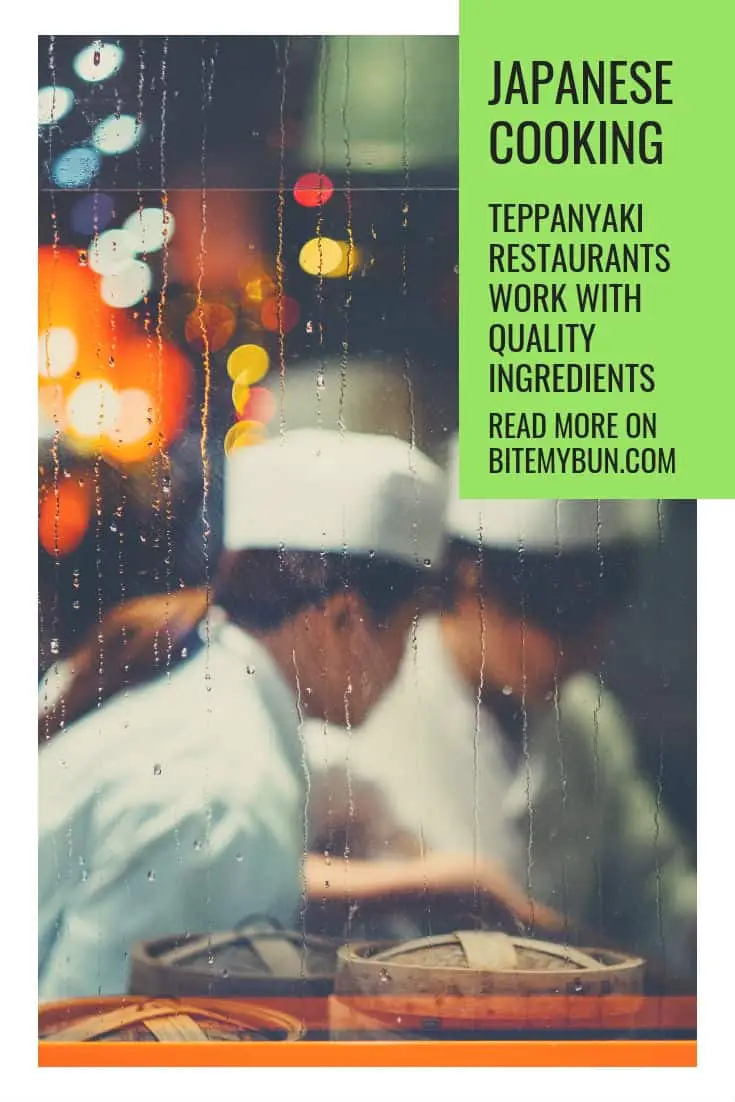
Teppanyaki cuisine is not only common in Japan, but it is also a popular cuisine in the Western world.
When it comes to Japanese-style teppanyaki, the ingredients that are usually utilized are seafood or chopped meat, cabbage, and yakisoba.
Vegetable oil, animal fat, or both are used to cook the ingredients. Beef is also an ingredient used by many restaurants in Japan.
They particularly feature high-quality beef brands such as Kobe, Matsusaka, and Akita.
However, some restaurants also offer less costly beef coming from the USA and New Zealand. The beef cuts in teppanyaki are either choice sirloin or tenderloin.
On the other hand, the common ingredients utilized in preparing Western teppanyaki include lobster, shrimp, chicken, beef, scallops, and veggies. All these are cooked using soybean oil.
Teppanyaki cuisines are served with a side dish. Ingredients used in preparing side dishes comprise zucchini,
Some restaurants offer dipping sauces; however, soy sauce is only provided in Japan.
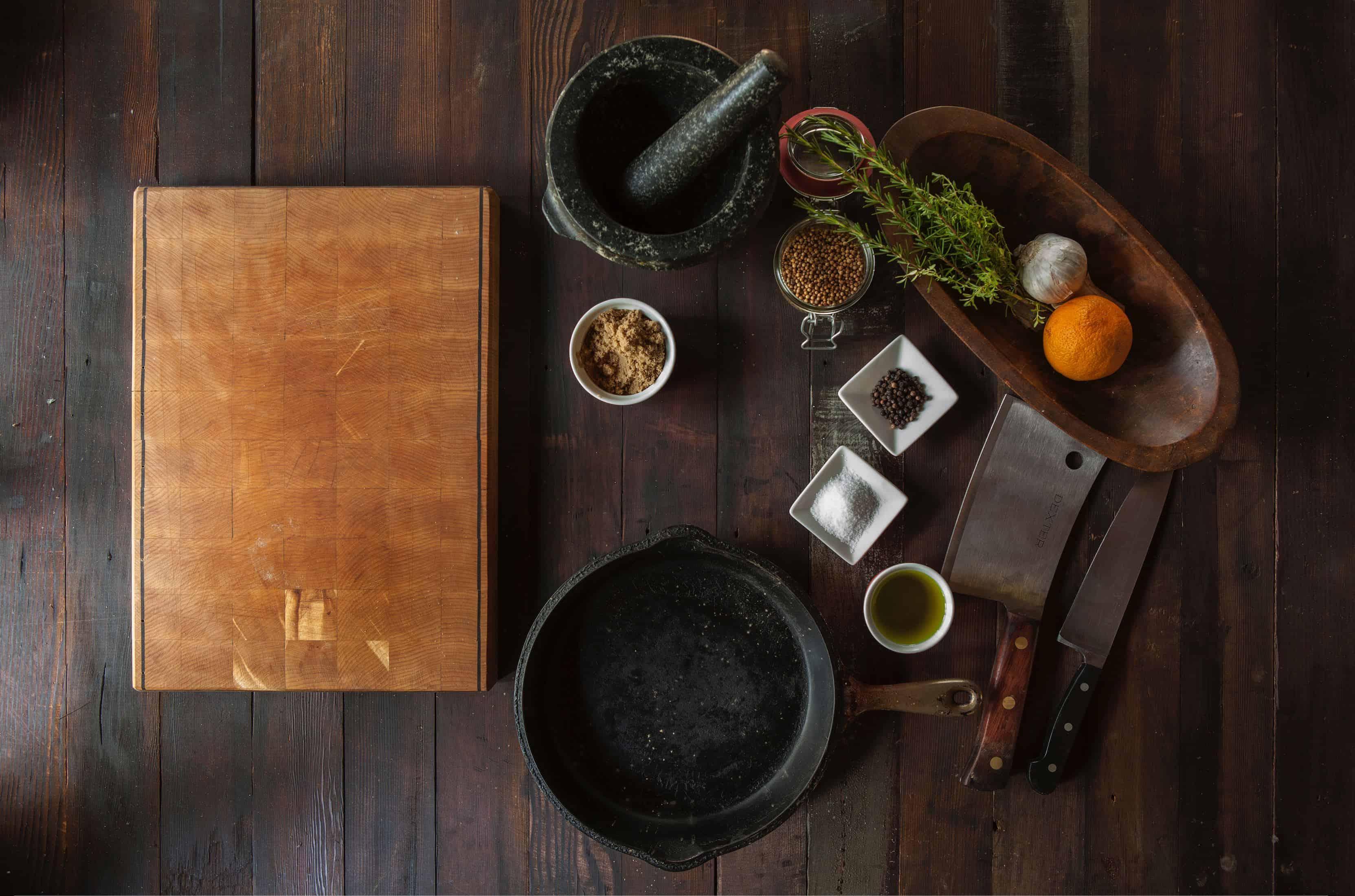
Teppanyaki Courses
Each restaurant offers various menus when it comes to teppanyaki; the most common of these is a Western-style course menu with a twist of Japanese course.
Normally, course menus begin with an appetizer like salad or soup, then a seafood course, the main course (a meat dish), a rice course, and a dessert including tea or coffee. The following are some of the teppanyaki courses:
- Beef Course
Since teppanyaki is a counterpart of the American steak in Japan, it is not surprising that the meat is the primary course of the meal.
Japanese teppanyaki dining allows you to savor the rich sweetness of top-quality black-haired wagyu beef.
- Rice Course
Fried rice and egg or risotto are also served during a teppanyaki dinner. The rice is directly cooked on a teppan cooktop.
Highly skilled chefs usually toss the egg into the air through a spatula prior to frying it.
- Seafood Course
In a seafood course, prawns and scallops are commonly grilled. When it comes to seafood course, Hokkaido black abalone and Ise spiny lobster are popular in Japan.
- Vegan Course
Teppanyaki vegan recipe includes fried vegetables with rice. Carrots, white cabbage, and julienned zucchini are some examples of these veggies.
Using a tangy sauce, these vegetables are sautéed. This can be served with or without starch.
- Dessert: Top off your teppanyaki meal with pastries, cake, or sorbet along with tea or coffee.
Teppanyaki as an Art
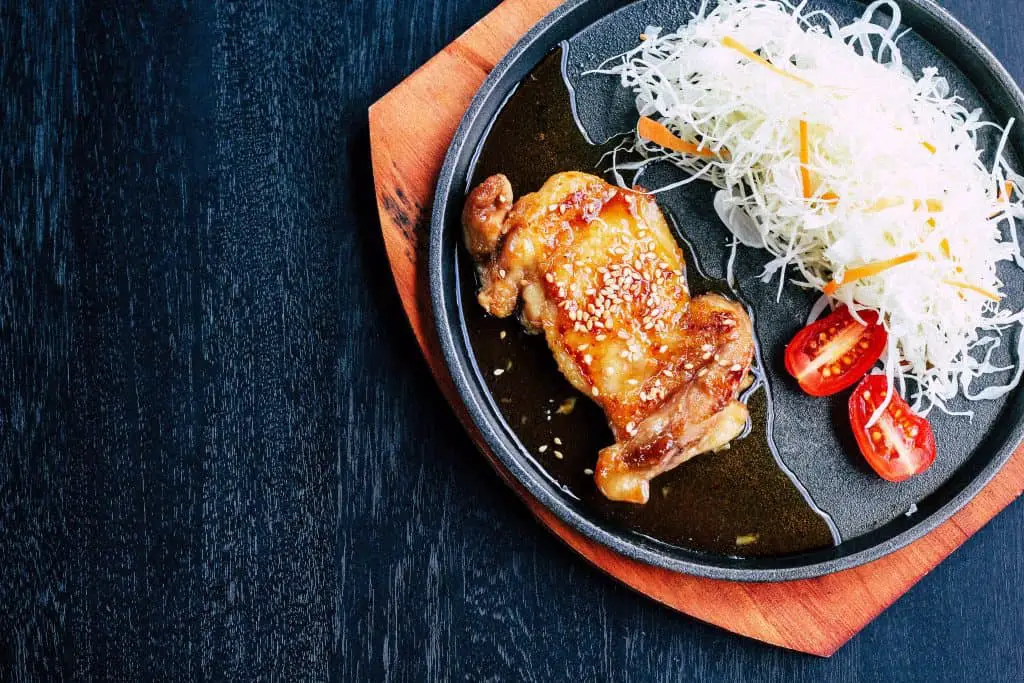
Although teppanyaki is a cooking style, it is also considered as a form of art. As a matter of fact, it is a blend of old-fashioned Japanese cooking methods and contemporary performance art.
As mentioned earlier, teppanyaki cuisines are prepared in front of diners.
In the long run, this concept has turned into a food entertainment or show.
Because of this, many Japanese movies and TV series usually highlight socially elite individuals enjoying their teppanyaki meal.
One main focus of teppanyaki dining is the chef’s ability to demonstrate various cooking techniques.
This enables guests to have a dining experience the same as the dinner theater.
The exhibitions that chefs do include cooked prawn flipping, precisely slicing or cutting meat or seafood, and flame setting to chopped onions.
Your teppanyaki experience won’t be complete without witnessing the art of teppanyaki cooking.
Japanese Teppanyaki & its meaning: how it came to Japan
Teppanyaki is a style of Japanese cuisine that uses an iron griddle to cook food.
The word teppanyaki is derived from teppan, which means iron plate, and yaki, which means grilled, broiled or pan-fried.
In Japan, teppanyaki refers to dishes cooked using an iron plate, including steak, shrimp, okonomiyaki, yakisoba, and monjayaki.
Modern teppanyaki grills are typically propane-heated flat surface grills and are widely used to cook food in front of guests at restaurants.
The world of culinary arts is surely a diverse one. There are just so many options and each a delight for your taste buds. But few are both delicious and an art form, that’s where Japanese Teppanyaki comes into play.
If you are neither a hardcore foodie nor a culinary expert – it is very obvious that you may have never heard of the term teppanyaki. 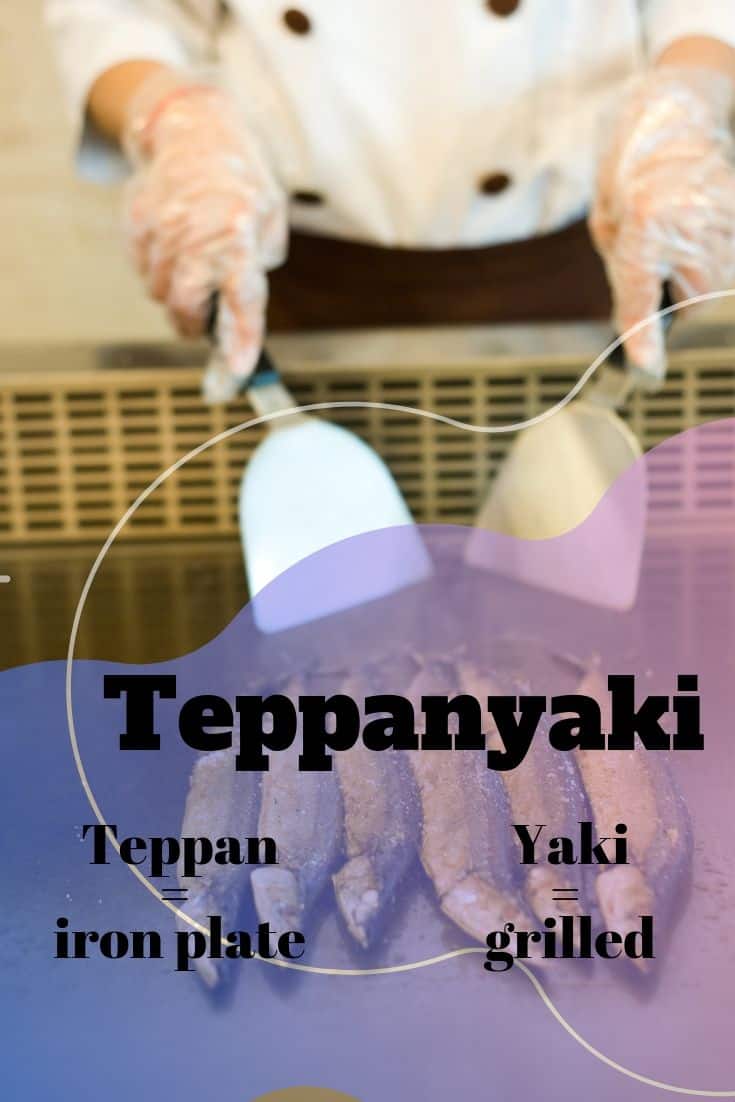 It’s gaining a lot in popularity though and quickly becoming a household name in America as well as all over the world.
It’s gaining a lot in popularity though and quickly becoming a household name in America as well as all over the world.
But trust me, you definitely came across it at least once. This is because the presence of teppanyaki is dominant even in Western culture, even more so in Western culture than in Japan, though it still is authentic Japanese cuisine.
Did you know it’s not that old? Let’s find about out that, and much much more in this in-depth post with all the information you’ll need on Teppanyaki and by the end of this article you will be an expert on the topic.
What does Teppanyaki mean?
Teppanyaki means “grilled on a flat iron plate”. When we break down the Japanese word teppanyaki you get: “teppan” 鉄板 which means iron plate and “yaki” 焼き simply meaning grilled. 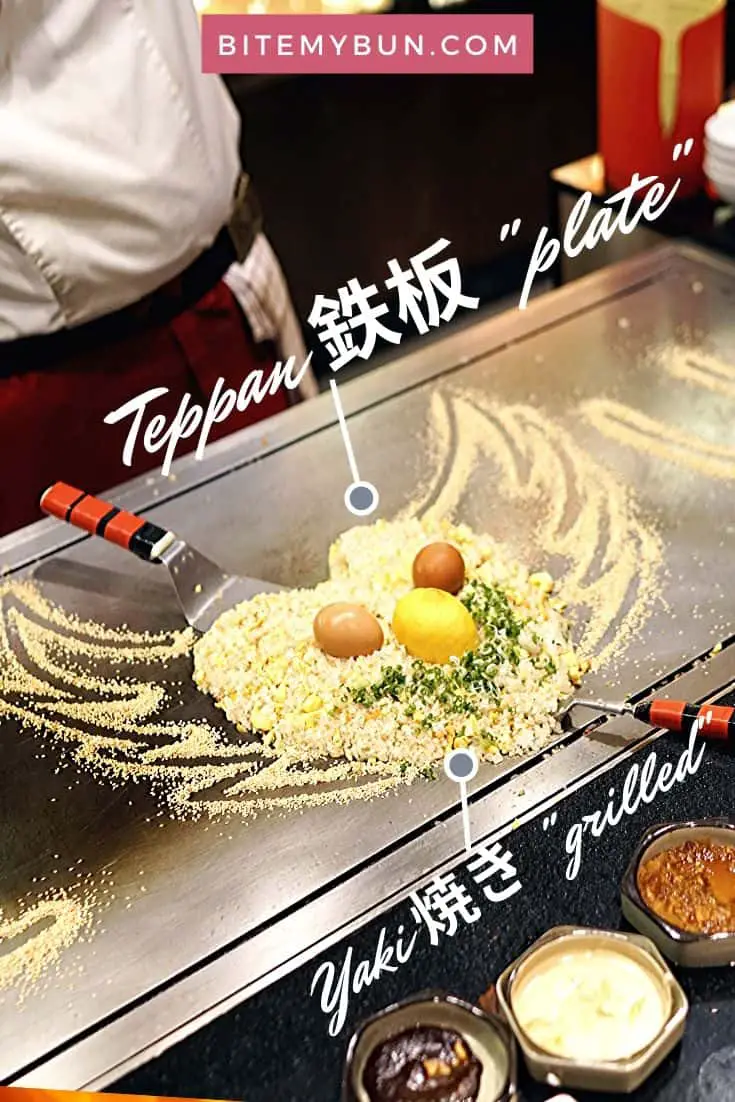
Like yaki in yakitori, which means grilled chicken skewers as tori means bird in Japanese.
In layman’s terms, teppanyaki is a Japanese cuisine that involves the use of a flat iron griddle to cook food.
You may be thinking that this is a very simple cuisine – but you would be so wrong.
Teppanyaki is one of the most complex forms of food preparation out there and it takes high levels of skill to master this form of cooking.
Here’s the art of Teppanyaki, a video by David Tran at his Benihana restaurant:
A brief history of Teppanyaki
When I say history in an article involving Japanese things – you all must be thinking of ancient times where ninjas and samurais were dominant.
But this would be a very common mistake; teppanyaki cuisine is relatively new but people assume it’s ancient due to the style of preparation.
It all began in 1945 when a restaurant chain called Misono where Shigeji Fujioka introduced the concept of cooking western food on a ‘teppan’. This idea was not so popular among locals at first as they found it to be very common, below them even. It was just not Japanese.
However, the restaurant chain observed that tourists were fascinated by this cuisine – mostly because of the knife skills that were displayed by the chefs right in front of them. It was obvious why Shigeji made his choice, as Japan was occupied by the Americans after World War II, and there wasn’t a better place than Kobe, which was Japan’s largest port, to create a cooking style that was able to remind the soldiers of their grilled beef from home.
It was something totally new in the culinary world at that time and it wás invented by the Japanese, just not authentic traditional Japanese cuisine.
Teppanyaki has seen remarkable growth in the US in the form of large chain restaurants, which were even more common in the 80’s than they are now.
Cooks at these diners cook meat and vegetables and even rice on a sweeping iron fire sear in front of their customers.
Dinner guests can appreciate watching the masterful cooking technique with culinary specialists’ fun execution style, which can lead to some exciting experiences if you’ve never seen it up close before:
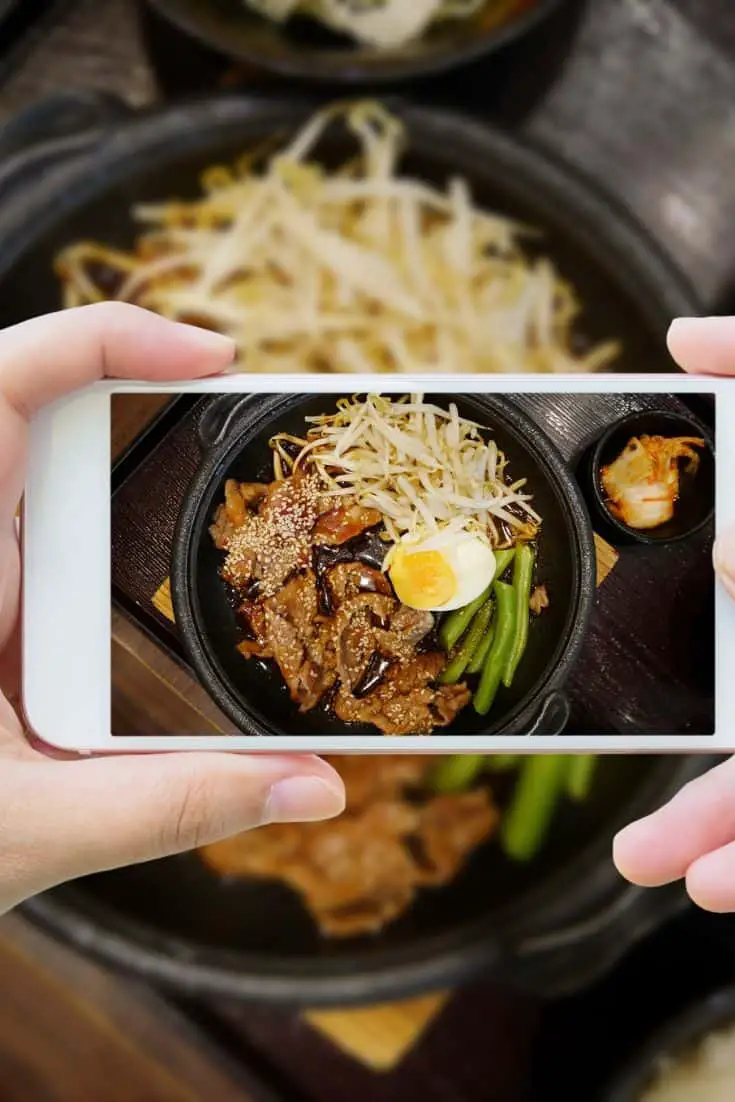
It’s like dinner ánd a show thrown together in one exciting package.
Teppanyaki restaurants in Japan though, have an exceptional one of a kind vibe compared to those in the US.
Want to get started in making Teppanyaki yourself? Check out our essentials buying guide to get you on the right track.
Teppanyaki is not Hibachi
Teppanyaki is regularly mistaken for Hibachi flame broiling.
Hibachi is different as it uses an open-grill flame broil, though teppanyaki utilizes a strong, frying pan style but large flat cooking surface.
This makes Teppanyaki appropriate for rice, onions, carrots and mushrooms which would otherwise fall through the grates. Often when people say they’re going to a hibachi place, they actually mean that they’re going to a restaurant where the chef cooks in front of them on a Teppanyaki grill plate. Also, a lot of people are calling it “tempanyaki” which is incorrect. They probably are mixing in tempura in the words because they ate that once at a sushi restaurant. Just know that Teppanyaki is the correct word for it.
Teppanyaki has a very interesting history, no doubt about that. However, it must be noted that this form of cooking is flourishing in modern times and is a key element in spreading Japanese culture all over the world.
The next time you see a traditionally dressed Japanese man boasting his knife skills at a restaurant, just know for sure that he is not a ninja but a great Teppanyaki chef!
Also read: the main differences between Hibachi and Teppanyaki
What is Teppanyaki cooking?
Teppanyaki refers to a dish of veggies, fish, and meat that is prepared using a large griddle that is commonly built into the table of diners.
The term teppanyaki comes from teppan, meaning iron plate, and yaki, meaning grilled, pan-fried, or broiled.
Teppanyaki is typically considered a live kitchen cooking method, wherein the chef prepares the dish in front of customers. The guests will then choose the cooking style that they desire and select the seasoning themselves. But you can of course cook Teppanyaki style yourself in your own home using one of the many tabletop grills or stovetop grills that are available.
The chef is trained in using the specialized cooking tools like a pro, and will do the rest of the preparations for you. Usually, each dish is prepared one at a time in order for the patron to appreciate the taste of the food and flair of the cooking style and make a whole evening out of the dining experience.
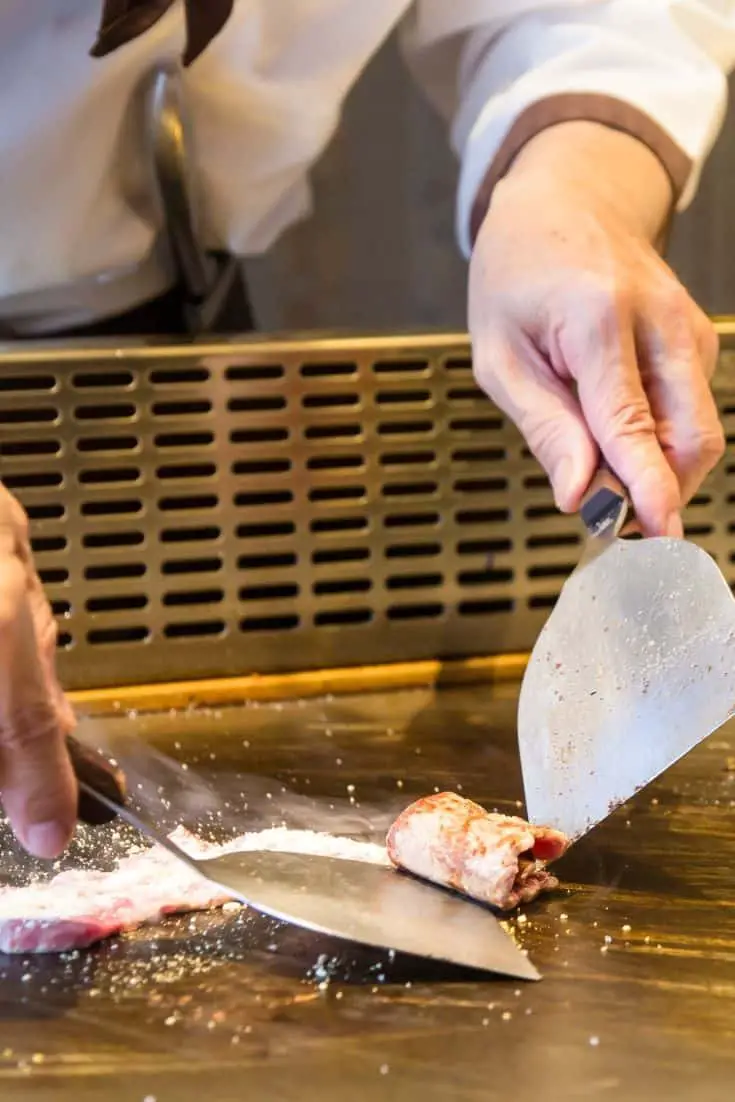
Teppanyaki should not be regarded as similar to barbecue grill.
The latter utilizes gas flame or charcoal and has an open grate structure, while the teppanyaki plate has a flat design, which is perfect when cooking small ingredients such as little cuts of meat, chopped veggies, egg, and rice.
If you’re not sure yet what types of grill to buy, it would be great to include a teppanyaki table on your list as well. I’ll explain the benefits of this type of cooking a bit more below.
The Beginning of Teppanyaki
Teppanyaki-style steakhouse was first served in a Japanese restaurant chain known as Misono. They originated the idea of cooking Western food on a teppan in 1945.
Teppanyaki has not been popular in Japan for centuries. This is regarded as a Japanese-style cooking method, but many people in Japan believe that this originated from Western countries. It was only influenced by American culture, but invented in Japan.
Advantages of Using a Teppanyaki Grill
A lot of traditional barbecue grills are designed to have grate openings, making it unsuitable to cook small pieces of food.
This is certainly different from those traditional grills since this is designed with a solid flat surface, enabling the user to grill food without throwing some portions away.
The ingredients are in direct contact of the surface of the grill, making the food’s juices to also be heated and cooked and retain there flavor.
Therefore, dishes prepared using a teppanyaki grill have enhanced flavor, most especially if these are accompanied with sauces.

Common Ingredients used in Teppanyaki
As mentioned earlier, teppanyaki is greatly influenced by Western cooking; therefore, the ingredients used are also westernized. These include lobster, shrimp, chicken, beef, scallop, and a wide variety of veggies.
The most common oil used in cooking the ingredients is soybean oil. Teppanyaki is also served with side dishes such as zucchini (although this is not common in Japan), mung beans, fried rice, and garlic chips.
International restaurants also provide special sauces, but only soy sauce will be offered when trying it in Japanese restaurants.
Selecting the Right Teppanyaki Grill
There are a wide variety of teppanyaki grill models that you can see in the market these days. The quality varies according to price and specifications.
If you want a grill that can be conveniently cleaned after using it, you may select a teppanyaki grill that is made up of stainless steel.
But if you prefer a grill that has the capacity to uniformly distribute heat throughout the surface, it is best to choose those grills that are made up of cast iron.
Since heat is evenly distributed, you can be assured that your ingredients can be properly cooked. When it comes to cooking location, there are teppanyaki grills that are suitable for outdoor use. Outdoor grill models utilize portable fuels such as liquid propane and natural gas.
The grill’s burner system is securely enclosed; thus, strong winds cannot interrupt its functionality. On the other hand, indoor models are powered by electricity, which is more convenient to use and set up.
For a good fit for you, you can check out my buying guide where I show what my choices were going forward in learning more about the culture and cooking styles of Japan, or directly look at my top list of grills.
Making Teppanyaki at home
After reading the first few parts of this article I understand you might be thinking that teppanyaki cannot be cooked at home. I’ve put a lot of emphasis on the chefs unique style and flair because that’s what people think of when talking about Teppanyaki.
But the essence of Teppanyaki is the ease in which you can cook on a large flat surface, moving around the ingredients and making sure they’re evenly cooked. You don’t need to learn the knife skills like they do at restaurants!
You are probably wondering when you get to throw knives and do all the cool stuff. To this I would say, that if you are not an expert don’t even think of doing crazy things like that as you might seriously injure yourself.
But if you are still willing to do so, (probably because you want to show it off to your friends) then take some classes that they have on teppanyaki cooking. For those of you who, like me, are more interested in the delicious food than the flair, here are some great recipes to try:
Teppanyaki recipes
There is a wide range of ingredients from which you can choose: beef, shrimp, lobster, chicken, scallops along with assorted vegetables.
Now although making teppanyaki at home in itself is easy, making it at restaurant level requires extensive practice.
Many Japanese restaurants feature many other forms of teppanyaki dishes like Kobe beef, Japanese noodles with sliced cabbage et cetera, but these are harder than the ones mentioned earlier. So, if you are a rookie, I’ll advise that you start with either regular beef or chicken. For the side dishes- it is totally up to you to make the call and one of the fun things of Teppanyaki is creating all of these little dishes and serving them. That makes Teppanyaki so great at parties. You can cook together at the table and eat lots of small dishes and flavor combinations. Choosing a side dish largely depends on the main course you’re preparing and also personal preference of course – but if you are unsure what to serve then a mix of different vegetables is always a safe option.
Make sure, however, that you don’t overcook or undercook them as a bad side dish will ruin the main dish, no matter how good that is.
Other than that, the equipment you require for teppanyaki is the regular set of knives you have at home. At the heart of this process is the iron girdle. So make sure you buy a good one.
The list of recipes for teppanyaki is huge – but they all share some basic steps. You can also try this Japanese teppanyaki recipe. The first step involves skillfully slicing your main ingredients i.e. beef, chicken etc. into small portions.
This is probably the most important step in the process because if the size is not proper than the iron girdle will not be able to cook it properly resulting in an overall disaster!
Before putting your main ingredients onto the iron grill, you should prepare your side dishes- like the vegetables first.
Side dishes normally can keep for a longer period after being cooked so it’s safe to fry them before your main dish.
The final step is the cooking itself which totally depends on the flame intensity as well as your ingredients. Therefore to master it you need tons of practice.
A common misconception about teppanyaki
For all the Japanese cuisines, teppanyaki is probably the most popular one, and rightfully so! However, this makes room for a ton of misconception. It is very common for anyone to mistake literally any Japanese cuisine for teppanyaki.
Hibachi, another Japanese cuisine, is probably the most underrated Japanese cuisine-because most of the time it is mistaken for teppanyaki!
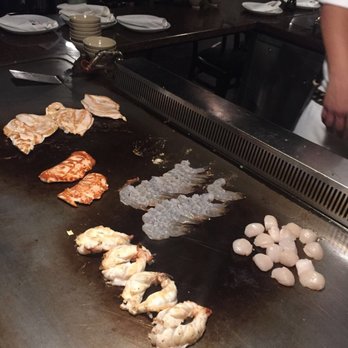
They have a very significant yet unnoticeable difference. Sounds weird right? What I mean by this is that if you are a culinary expert the difference will be very obvious to you but if you’re not then you might not notice it all. What is teppanyaki style cooking? Teppanyaki style cooking just means the food has been prepared on a flat iron grill. In short that’s all there is to it. What most people mean additionally is that it’s made by a chef with impressive knife skills, or that it’s made with a particular sauce for flavor.
The term hibachi literally translates to fire bowl. This is because the grill used for hibachi cuisines is a very unique cylindrical vessel with fire proof lining.
They put charcoal on it and then cook their food in it. For teppanyaki, as we know already an iron griddle is used.
The ingredients of teppanyaki and hibachi are very similar, which perhaps is one of the reasons that this confusion arises.
The cooking process yields completely different tastes. I personally prefer teppanyaki but this is subject to my personal preference.
Other than that, both hibachi and teppanyaki are more than just cuisines in Japan. They are a form of art and both deserves equal appreciation.
Teppanyaki has made a greater impact because it normally works with Japanese steaks and we all know that Japanese steaks are the best in the world!
Teppanyaki is easy to make at home relative to hibachi and also the availability of the iron griddles is more common than the special cooking vessel required for hibachi.
Final thoughts
So, now you probably know a lot about teppanyaki, and you may be wondering how you can implement this knowledge.
There are many ways to do this:
- you can experience a better taste of teppanyaki because you now know better which dishes to choose,
- or you can show-off your teppanyaki skills to your friends,
- you can even open your very own teppanyaki restaurant if you have the will to do so.
There are people that say teppanyaki isn’t good and that’s completely fine because food is like music- everyone has their own opinion and everyone’s opinion needs to be respected.
As for myself, I cannot imagine a weekend without my teppanyaki.
Teppanyaki restaurant chains are very common in the US, you can find tons of them in every major city. Teppanyaki is also not so expensive like other foreign cuisines so it’s an affordable night out.
Teppanyaki is an excellent example of cultural integration- and definitely a delicious one! I hope this article has helped you understand what teppanyaki really is and now you can probably be a ‘ninja’ in your own kitchen to make delicious food.
You will be amazed once you try teppanyaki, I can assure you.
Teppanyaki started in Japan about 200 years ago. It was in 1945 that the first teppanyaki restaurant, Misono, was opened in Kobe.
As claimed by Misono, they were the first restaurant that popularized the concept of cooking food on a grill in front of customers.
What’s interesting is that this style of cooking became more famous in foreign countries than in Japan.
A lot of foreigners love to witness the highly skilled chefs maneuvering the ingredients.
When Misono became more popular with tourists, they decided to improve the performance portion of the food preparation.
Chefs now perform food stunts (e.g., stacking onions to form a flaming onion volcano).
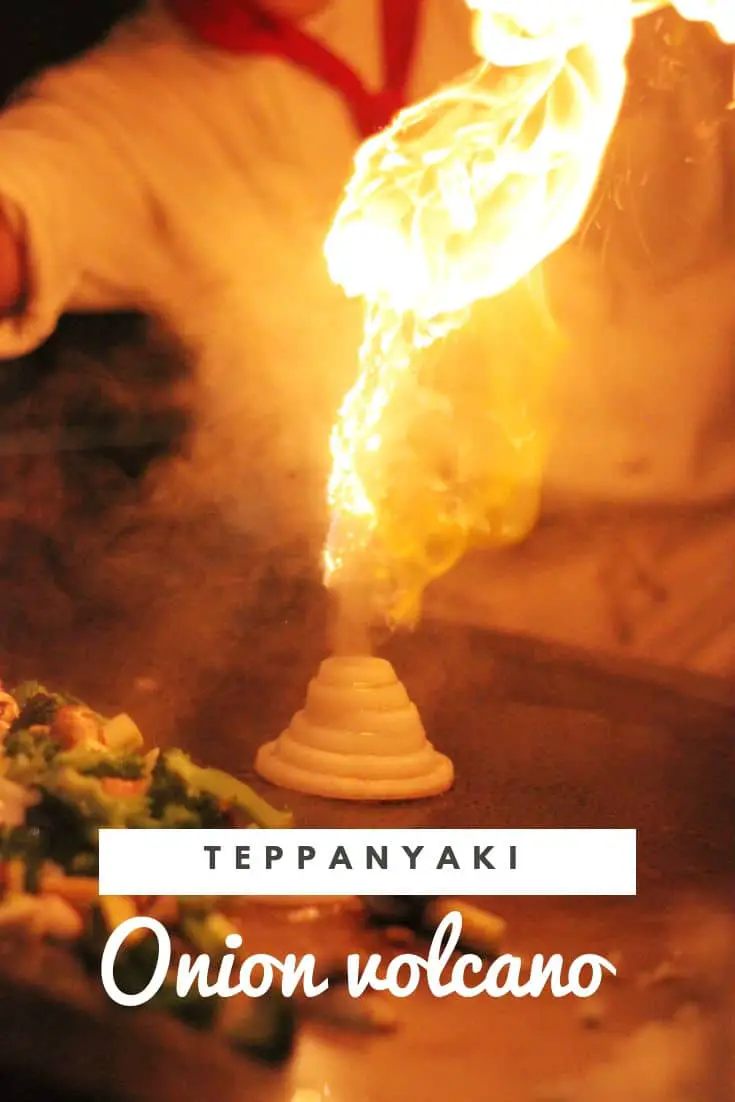
This is a text overlay image of the original work Kono Hibachi, Myrtle Beach by Ginny on Flickr under cc. What an amazing shot of Teppanyaki in action!
After World War II, teppanyaki was introduced in Western society. Until in 1964, the first US teppanyaki restaurant, Benihana, was opened in New York.
As the years go by, teppanyaki has evolved. It is not about cooking anymore, but it became a form of art.
The Japanese are known for their creativity and they have a reputation of turning basically anything into a form of art, and cooking is no exception.
Teppanyaki cooking began in Tokyo as locals began using a hot plate grill and one can’t help but notice that not every aspect of this cooking style is Japanese.
It came as a surprise to the locals when a restaurant in downtown Tokyo known as Misono began using a table-side grill to do its cooking in 1945.
A combination of entertainment and Teppanyaki dishes such as ‘flaming onion volcanoes’ propelled Misono to global fame.

Plus points of Teppanyaki dishes
Teppanyaki dishes are very low on fat and are considerably light since very little oil is involved in the cooking.
When ordering teppanyaki dishes in a restaurant, you are given the option of deciding exactly how you want it prepared.

You can decide the kind of seasoning and the amount of oil that suits your taste. The food comes in small portions but adequate. It is the kind of food that would definitely be recommended for health-conscious folks.
It is also safe to say that the ingredients used in teppanyaki cooking are recommendable as far as health is concerned.
The popularity of Japanese steak houses has made Teppanyaki a household name in America. The teppanyaki style of cooking is also used in preparing yakisoba (noodles) with seafood or sliced meat using vegetable oil or animal fat.
It has evolved over the years into an interesting style that is no longer considered as just cooking but as a form of art.
Read more: Important table manners in Japanese food culture
